Some health and fitness “authorities” make using body fat calipers sound like a tricky business, as if it’s beyond the grasp of the average gymgoer.
In truth, measuring body fat with calipers is actually pretty simple: you pinch and measure specific “sites” on your body, then use equations or a body fat calipers calculator to arrive at an estimate of your body fat percentage.
Of course, to get accurate results you have to know how to do this correctly. You also have to understand and decide on which method of measuring body fat with calipers to use.
And that’s precisely what you’ll learn in this article.
You’ll discover everything you need to know about how to use calipers to measure body fat accurately, including how to do the most common body fat calipers tests such as the 3-, 4-, and 7-site Jackson-Pollock skinfold methods, the Parrillo skinfold method, the Durnin/Womersley skinfold method, and the Navy tape measure method.
What Are Skinfold Calipers?
Skinfold calipers (or “body fat calipers”) are devices used to measure your body fat percentage (a caliper is any device that measures the dimensions of an object).
To estimate your body fat percentage with skinfold calipers, you measure the thickness of the skin and fat underneath (subcutaneous fat) on particular points of your body, then plug these measurements into a mathematical formula that estimates your body fat percentage.
Are Skinfold Calipers Accurate?
For people with average or above-average amounts of body fat (15% and higher for men, or 25% and higher for women), body fat calipers are a fairly accurate way to measure body fat percentage.
In leaner people, however (less than 15% for men or 25% for women), body fat calipers tend to underestimate body fat percentage, with the results becoming more skewed the leaner you get.
For example, if you’re a man around 8 or 9% body fat, skinfold calipers will likely give you a reading closer to 5%. And if you’re a woman around 19-to-20% body fat, you could get a reading closer to 12 or 14%.
This doesn’t mean body fat calipers are useless if you’re lean. You just have to look at them as a tool for assessing trends rather than as a precise method of measuring your body fat percentage.
That is, although calipers might not accurately estimate your body composition, they can reliably indicate whether you’re losing fat, gaining fat, or maintaining your body fat level based on whether the measurements go, down, or stay the same.
Remember, too, that accurately measuring your body fat percentage isn’t necessary or even all that useful for getting into great shape. Although setting a body fat percentage goal can be motivating (e.g. “I want to get down to 20% body fat”), what matters most is that you’re happy with what you see in the mirror.
Provided you are, your precise body fat percentage is irrelevant.
How to Measure Body Fat with Calipers
Measuring body fat with calipers isn’t as tricky as some would have you believe. That said, it takes a little practice before you can do it quickly and accurately.
Until you’ve mastered the process, it’s sensible to refer to this guide whenever you measure your body fat. That way, you can be sure the measurements are consistent and reliable.
Here are the steps you need to follow to take body fat caliper measurements:
How to Use Body Fat Calipers
1.) Pinch your skin by placing the thumb and forefinger on your body about two inches apart, firmly pushing them into your flesh like this:
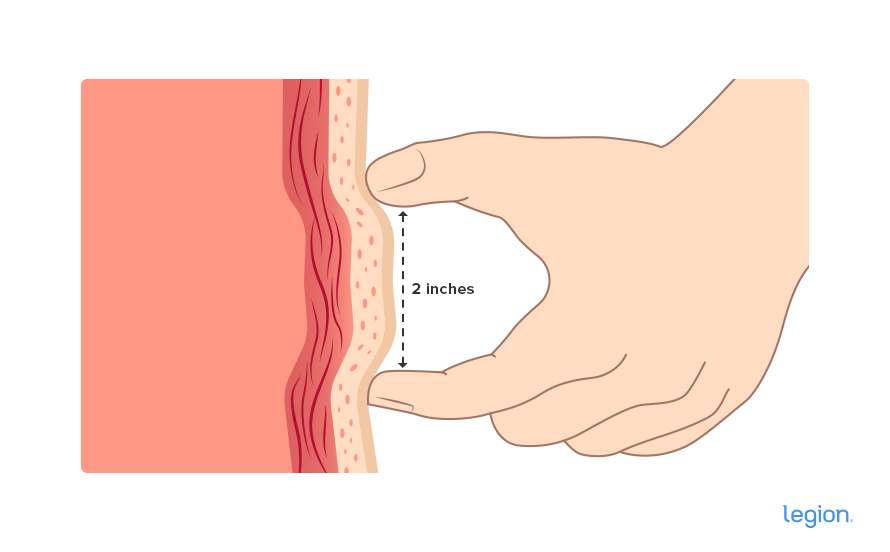
(Note: If there’s a lot of fat in the area, you may need to increase the distance between your thumb and forefinger to grasp and pull the skinfold).
2.) Push your fingers together, then gently pull the skinfold away from your body, like this:
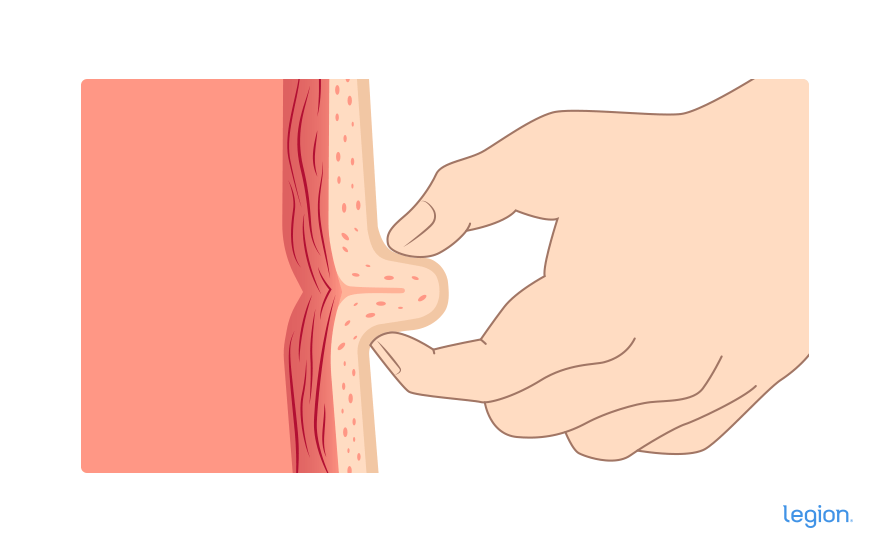
3.) Measure a pinched skinfold by placing the tips of the caliper in the middle of the skinfold about an inch from your fingers. For example, the illustration below shows someone taking a suprailiac skinfold measurement:
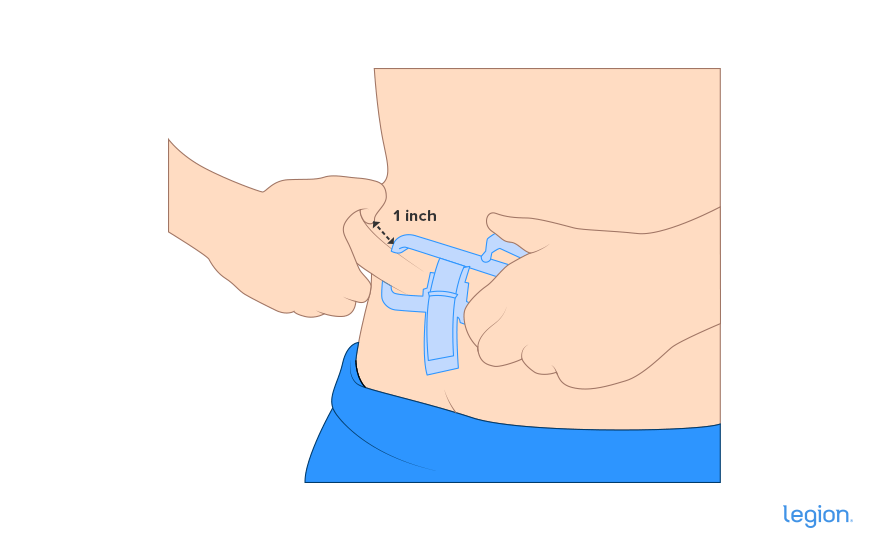
4.) Compress the caliper until it clicks (and no more), and note the measurement, like this:
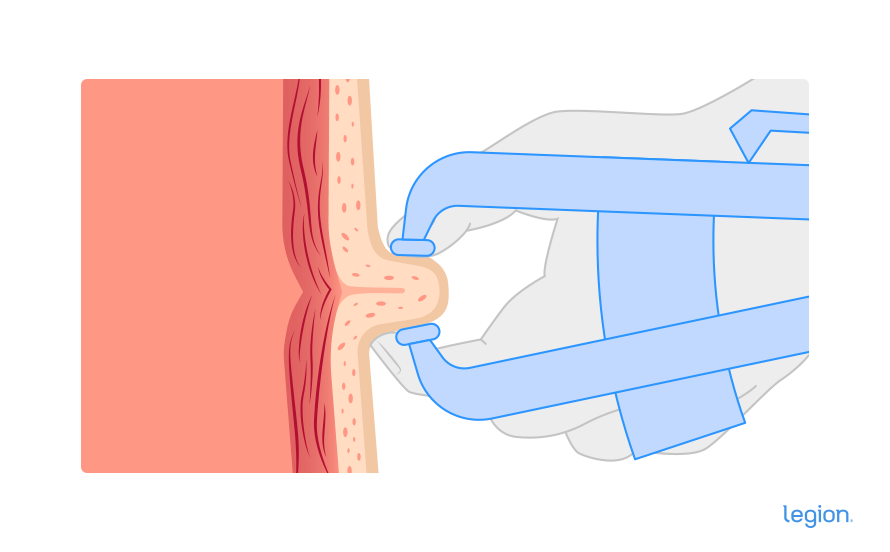
5 Tips for Measuring Body Fat With Calipers Accurately
Learning how to measure body fat with calipers takes practice, so here are five tips to help you get more accurate readings.
- Take all measurements on the right side of your body while standing with your muscles relaxed.
- Ensure your skin is dry and lotion-free (towel off if you’re taking your measurements after showering).
- Don’t take measurements after doing anything physically strenuous (like a workout) or when you’re particularly hot (this can temporarily boost your skinfold thickness by increasing the amount of fluid beneath your skin).
- Try to take body fat caliper measurements at the same time of day every time you take them.
- If you’re a woman, avoid taking body fat caliper measurements at any time during your menstrual cycle when you gain a noticeable amount of weight.
The Skinfold Sites and How to Measure Them
- Abdominals: Pinch a vertical fold of skin one inch to the right of your belly button.
- Biceps: Pinch the skin vertically halfway between the elbow and shoulder on the front of your arm.
- Calf: Pinch the skin vertically on the inside of the largest part of the right calf.
- Lower back: Pinch the skin horizontally about 6 inches above the waist and 2 inches to the right of the spine.
- Midaxillary: Pinch the skin vertically directly below the armpit at the same height as the base of your breastbone.
- Pectoral: For men, pinch a diagonal skinfold halfway between the front edge of your armpit and your right nipple. For women, pinch a diagonal skinfold about two-thirds of the way from your right nipple to the front edge of your right armpit (i.e. closer to your armpit than your nipple).
- Subscapular: Pinch the skin diagonally an inch beneath the middle of your shoulder blade (about three inches to the right of your spine and six inches above your waist).
- Suprailiac: Pinch the skin diagonally directly above the bony protrusion on the front of the right hip (the iliac crest).
- Thigh: Pinch the skin vertically halfway between the top of the kneecap and the top of the front of your thigh.
- Triceps: Pinch the skin vertically halfway between the elbow and shoulder on the back of your arm.
Now let’s look at the most common methods of measuring body fat with calipers and which parts of your body you need to measure for each.
You can find all of the equations you need to calculate your body fat percentage below. Be warned: Some of them are knotty, so it’s best to have a graphing calculator on hand if you want to tackle them yourself.
An easier solution is to plug your measurements into the calculator below, and it’ll do all the number crunching for you:
The Legion Body Fat Percentage Calculator
3-site Jackson-Pollock Skinfold Method
The 3-site Jackson-Pollock skinfold formula is one of the most popular ways to measure body fat percentage because it’s easy, quick, and reliable.
That said, it tends to underestimate the body fat percentage of people who are fairly lean (men under 15% body fat and women under 25%). Thus, it’s more accurate for people with more body fat than this.
If you’re a woman, take a triceps, thigh, and suprailiac measurement (in millimeters), then use the following equations to calculate your body fat percentage:
Body Density = 1.0994921 – (0.0009929 x sum of skinfolds) + (0.0000023 x square of the sum of skinfolds) – (0.0001392 x age)
Body Fat Percentage = (495 / Body Density) – 450
If you’re a man, take a pectoral, abdominal, and thigh measurement (in millimeters), then use the following equations to calculate your body fat percentage:
Body Density = 1.10938 – (0.0008267 x sum of skinfolds) + (0.0000016 x square of the sum of skinfolds) – (0.0002574 x age)
Body Fat Percentage = (495 / Body Density) – 450
4-site Jackson-Pollock Skinfold Method
The 4-site Jackson-Pollock skinfold formula is marginally more accurate than the 3-site formula, but also tends to slightly underestimate the body fat percentage of people who are fairly lean.
Thus, it works better for people with more body fat than this.
If you’re a woman, take a triceps, thigh, suprailiac, and abdominal measurement (in millimeters), then use the following equations to calculate your body fat percentage:
Body Density = (0.29669 x sum of skinfolds) – (0.00043 x square of the sum of skinfolds) + (0.02963 x age) + 1.4072
Body Fat Percentage = (495 / Body Density) – 450
If you’re a man, take a thigh, triceps, suprailiac, and abdominal measurement (in millimeters), then use the following equations to calculate your body fat percentage:
Body Density = (0.29288 x sum of skinfolds) – (0.0005 x square of the sum of skinfolds) + (0.15845 x age) – 5.76377
Body Fat Percentage = (495 / Body Density) – 450
7-site Jackson-Pollock Skinfold Method
The 7-site Jackson-Pollock skinfold formula isn’t much more accurate than the 3-site formula. It also requires significantly more effort and tends to slightly underestimate the body fat percentage of people who are fairly lean.
Thus, it’s normally better to use the 3-site method.
For the 7-site body fat calipers test, men and women take the same measurements but use different equations to calculate their body fat percentage.
If you’re a woman, take a pectoral, abdominal, thigh, triceps, subscapular, suprailiac, and midaxillary measurement (in millimeters), then use the following equations to calculate your body fat percentage:
Body Density = 1.097 – (0.00046971 x sum of skinfolds) + (0.00000056 x square of the sum of skinfold sites) – (0.00012828 x age)
Body Fat Percentage = (495 / Body Density) – 450
If you’re a man, take a pectoral, abdominal, thigh, triceps, subscapular, suprailiac, and midaxillary measurement (in millimeters), then use the following equations to calculate your body fat percentage:
Body Density = 1.112 – (0.00043499 x sum of skinfolds) + (0.00000055 x square of the sum of skinfold sites) – (0.00028826 x age)
Body Fat Percentage = (495 / Body Density) – 450
9-site Parrillo Skinfold Method
The 9-site Parrillo skinfold formula isn’t well studied, so it’s hard to say how accurate it is compared to the other formulas.
For that reason, I recommend you use a more established method such as the 3-site Jackson-Pollock skinfold formula or the Navy tape measure method.
For the 9-site body fat calipers test, men and women take the same measurements and use the same equations to calculate their body fat percentage.
Whether you’re a man or a woman, take a pectoral, abdominal, thigh, biceps, triceps, subscapular, suprailiac, lower back, and calf measurement (in millimeters), then use the following equation to calculate your body fat percentage:
Body Fat Percentage = (27 x sum of skinfolds sites) divided by bodyweight (lb.).
4-site Durnin/Womersley Skinfold Method
The 4-site Durnin/Womersley skinfold formula can produce accurate results for some people. However, most find it overestimates body fat percentage.
Thus, I recommend you use a more accurate method such as the 3-site Jackson-Pollock skinfold formula of the Navy tape measure method.
For the 4-site body fat calipers test, men and women take the same measurements (in millimeters) but use different equations to calculate their body fat percentage depending on their age.
(Note: In the following equations, D = Body Density and L = Log of the sum of skinfolds.)
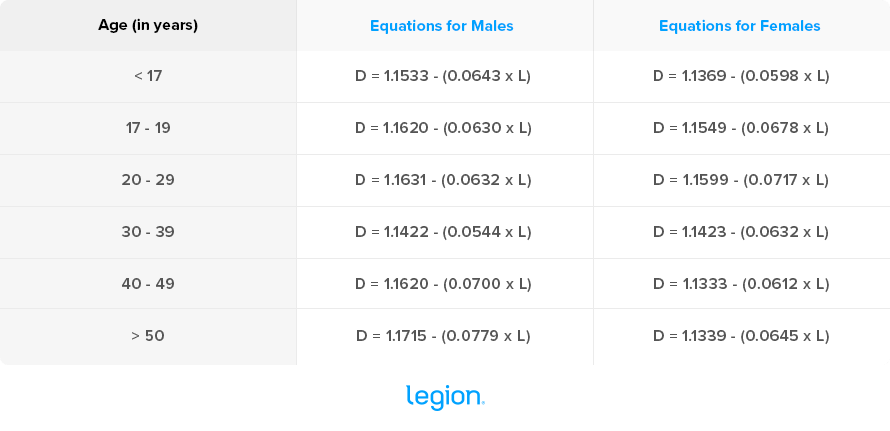
Body Fat Percentage = (495 / Body Density) – 450
The Navy Tape Measure Method
The Navy tape measure method doesn’t use body fat calipers, but it’s still worth a mention because it’s a simple, fast, and reliable way to measure your body fat percentage.
Although this method is fairly accurate, it also tends to overestimate the body fat percentage of people who are fairly lean. Thus, it’s best used for men over 15% body fat and women over 25%.
Here are the measurements you need to take for the Navy tape measure method, and how to take them accurately:
- Height: Ideally, measured using a stadiometer—a device for measuring height—or a measuring tape held against the wall.
- Neck: Wrap the tape measure around your relaxed neck with the tape angled slightly downward in front.
- Waist: Wrap a tape measure around your bare waist at the height of your navel. Don’t suck in your stomach.
- Hips: Place your feet together and wrap a tape measure around your bare hips at their widest point (so that it passes over the widest part of your butt).
If you’re a woman, take a height, neck, waist, and hips measurement (in inches), then use the following equations to calculate your body fat percentage (you’ll want to use a graphing calculator for this one):
Body Fat Percentage = 163.205 x log10 (waist + hip – neck) – 97.684 x log10 (height) – 78.387
If you’re a man, take a height, neck, and waist measurement (in inches), then use the following equations to calculate your body fat percentage:
Body Fat Percentage = 86.010 x log10 (abdomen – neck) – 70.041 x log10 (height) + 36.76
Or, just select the Navy Tape Measure Method when using The Legion Body Fat Percentage Calculator.
FAQ #1: What are the best body fat calipers?
Personally, I like the Accu-Measure body fat calipers because they’re easy to use, accurate, and affordable (which is probably why they’re endorsed by the World Natural Bodybuilding Federation as the premiere body fat caliper on the market).
FAQ #2: Where should I buy body fat calipers?
You can buy body fat calipers online, from sporting goods stores, and even from some grocery stores.
While none of these options are inherently better than the others, you tend to find online stores like Amazon have a wider range of products available at slightly lower prices (the Accu-Measure body fat calipers only cost $15, though, so I recommend you go with those).
FAQ #3: How accurate are body fat calipers?
So long as your body fat percentage is higher than 15% (men) or 25% (women), body fat calipers are reasonably accurate.
If your body fat percentage is below 15% (men) or 25% (women), however, body fat calipers tend to underestimate body fat percentage.
Regardless of your body fat percentage, if you don’t take skinfold measurements properly, they’re likely to produce inaccurate results (that’s why learning how to use body fat calipers is paramount).
FAQ #4: How do I use a body fat calipers chart?
A body fat calipers chart works in a very similar way to a body fat calipers calculator: it helps you calculate your estimated body fat percentage without having to do any of the arithmetic yourself.
To use most body fat calipers charts, you take measurements (usually three or four depending on the calipers and chart you use), add the readings together, then refer to the right chart for your age and sex (there are different charts for adults and children, and males and females) to find your estimated body fat percentage.
Usually, this requires you to find the sum of your caliper measurements on one axis, your age on the other, and then trace your fingers to the point at which those two lines intersect on the chart.
Before body fat calipers calculators were readily available online, using a body fat calipers chart was the least effortful way to calculate your body fat percentage based on your caliper measurements. Now, however, body fat calipers calculators make the process even simpler, which is why they tend to be the preferred method of calculating body fat percentage based on caliper measurements.
That said, there are some charts that enable you to estimate your body fat percentage based on a single caliper measurement.
These charts are still useful because they make estimating your body fat percentage quick and easy. The only downside is that they tend to be less accurate than other methods, so they should only ever be used to get a ballpark estimate of body fat percentage rather than a precise measurement.
Here’s a single-site body fat caliper chart for men:
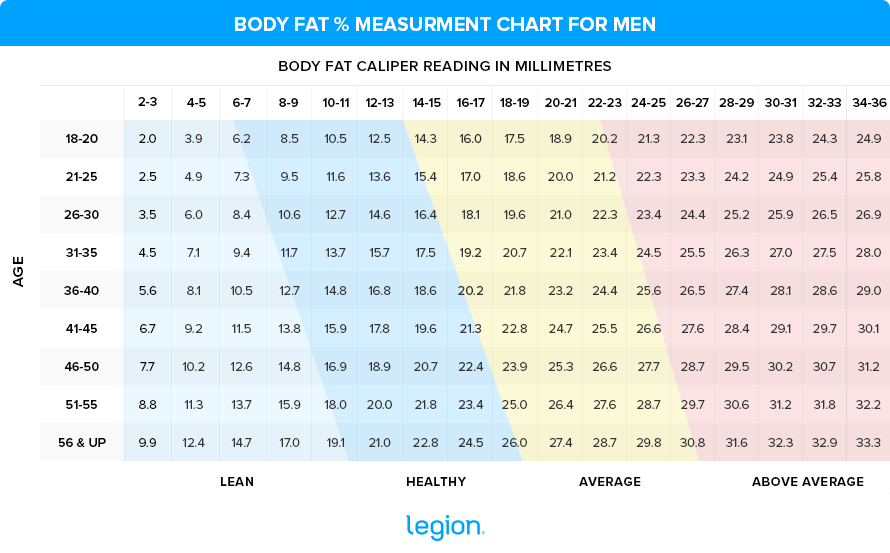
And here’s a body fat caliper chart for women:
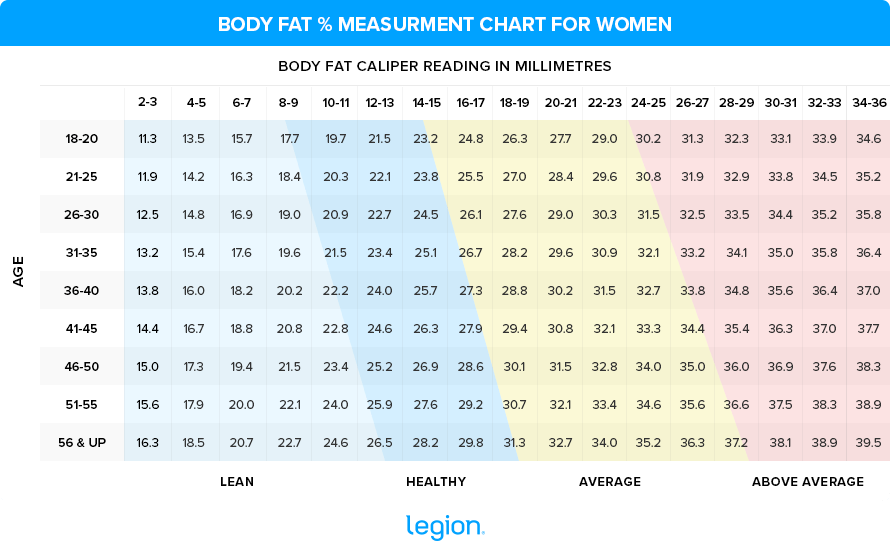
To use these body fat calipers charts, follow these steps:
- Take a body fat caliper measurement in millimeters at your suprailiac (to find the suprailiac, pinch the skin diagonally directly above the bony protrusion on the front of your right hip).
- Using the body fat calipers chart, find your caliper reading in millimeters in one of the white boxes across the top, then trace a line down the chart with your finger.
- Find your age range in one of the white boxes in the leftmost column, then trace a line horizontally to the right across the chart with your finger.
- Your estimated body fat percentage is in the box where these two traced lines intersect on the chart.
For example, if your suprailiac measurement from step one is 14.5 millimeters and you’re 38 years old, your estimated body fat percentage would be 18.6%.
Note: If your measurement is over 36 mm, add 0.25% for every millimeter pinched above 36 mm.
FAQ #5: Are digital body fat calipers more accurate than manual body fat calipers?
No. Digital body fat calipers and manual body fat calipers are equally accurate, provided you use them correctly.
The benefits of digital body fat calipers are that they tend to be easier to read and they can quickly convert imperial measurements to metric (and vice versa). The downside is that they’re typically more expensive than manual calipers.
FAQ #6: Where can I find a good body fat calipers calculator?
Instead of using formulas to translate your body fat calipers measurements into an estimated body fat percentage, you can plug your numbers into a body fat calipers calculator (or “body fat percentage calculator”), and it will do all the math for you.
You can find a body fat percentage calculator that uses your gender, weight, age, and preferred body fat calipers measurement method to estimate your body fat percentage here:
The Legion Body Fat Percentage Calculator

